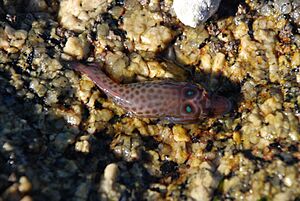Cornish sucker facts for kids
Quick facts for kids Cornish sucker |
|
|---|---|
 |
|
| Conservation status | |
| Scientific classification |
The Cornish sucker, also known as Lepadogaster purpurea, is a small and unique fish. It belongs to a special group of fish called clingfish. These fish are part of the family Gobiesocidae. You can find this interesting creature in the eastern North Atlantic Ocean and the western Mediterranean Sea. It's known for its amazing ability to stick to rocks!
Contents
About the Cornish Sucker
What Does It Look Like?
The Cornish sucker has a body shape a bit like a tadpole. It has a small body but a large, flat head. Its mouth is wide, shaped a bit like a duck's bill. Behind each nostril, it has a small tentacle.
One of its most special features is its "sucker." This is formed by its pelvic fins, which are joined together. This suction disc helps the fish cling tightly to surfaces.
Amazing Color Changes
Cornish suckers can change their color! This helps them blend in with the rocks or sand they are clinging to. They can be pale with patterns of bars and spots. These colors can range from dark purple to reddish-brown or even green.
On the back of their neck, they have two bright blue spots. These spots look like eyes and are called ocelli. Scientists think these "eyespots" help confuse predators. They might make the fish look bigger or trick a predator into attacking the wrong part of its body. These fish can grow up to about 7.5 centimeters (3 inches) long.
Where Do They Live?
The Cornish sucker lives in the eastern North Atlantic Ocean. You can find them from the Shetland Islands in the north, all the way south to the Canary Islands and Dakar in Senegal. They also live in the western Mediterranean Sea. Their range extends as far east as Cap Roux, which is near Cannes, France.
How Do They Live?
Cornish suckers like to live on rocky shorelines. They are usually found just below or just above the low water mark. They can live as deep as 9 meters (30 feet) underwater.
These fish often hide under boulders. They spend a lot of time in these shelters. They usually have a favorite hiding spot they return to. When they see food nearby, they wait for it to come closer. Then, they quickly swim out to grab their prey. After catching their meal, they swim straight back to their shelter to eat it.
Fish Family Tree
The Cornish sucker is one of three species in the Lepadogaster group. For a while, scientists thought the Cornish sucker was the same as another fish called Lepadogaster zebrina. However, they later found out it was its own unique species.
Studies have shown that the Cornish sucker acts differently from its relatives. It tends to be much more passive. This means it's less active in its habitat. It spends more time inside its shelter. It doesn't swim around as much or interact with other fish as often. The Cornish sucker also swims at a slower pace. It doesn't make quick, darting movements like some other clingfish, such as the shore clingfish.


